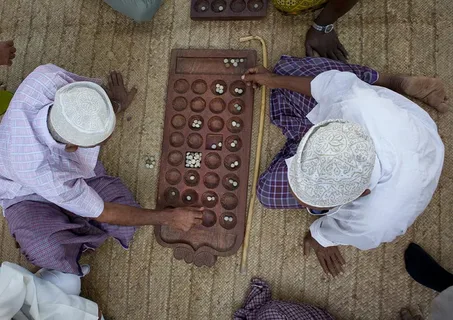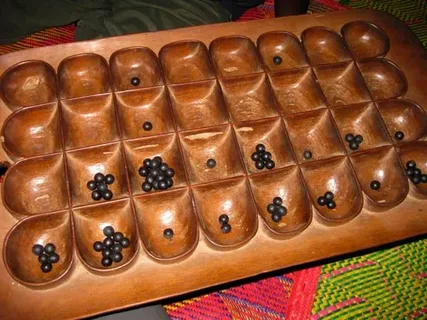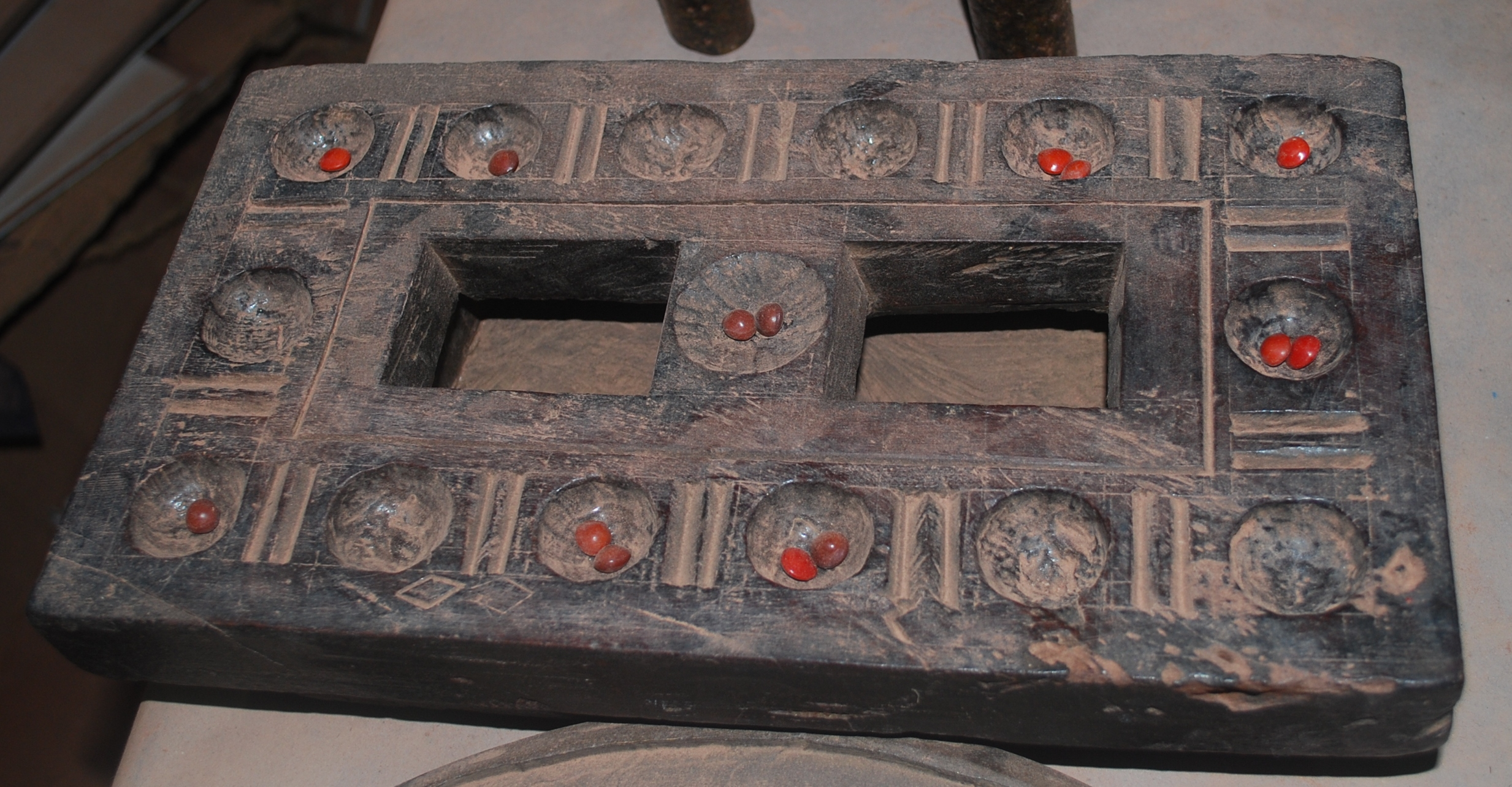Most mancala games share a common general gameplay. Players begin by placing a certain number of seeds, prescribed for the particular game, in each of the pits on the game board. A player may count their stones to plot the game. A turn consists of removing all seeds from a pit, “sowing” the seeds (placing one in each of the following pits in sequence), and capturing based on the state of the board. The game’s object is to plant the most seeds in the bank. This leads to the English phrase “count and capture” sometimes used to describe the gameplay. Although the details differ greatly, this general sequence applies to all games.
If playing in capture mode, once a player ends their turn in an empty pit on their own side, they capture the opponent’s pieces directly across. Once captured, the player gets to put the seeds in their own bank. After capturing, the opponent forfeits a turn.
Equipment is typically a board, constructed of various materials, with a series of holes arranged in rows, usually two or four. The materials include clay and other shapeable materials. Some games are more often played with holes dug in the earth, or carved in stone. The holes may be referred to as “depressions”, “pits”, or “houses”. Sometimes, large holes on the ends of the board called stores, are used for holding the pieces.
Playing pieces are seeds, beans, stones, cowry shells, half-marbles or other small undifferentiated counters that are placed in and transferred about the holes during play.
Board configurations vary among different games but also within variations of a given game; for example Endodoi is played on boards from 2×6 to 2×10. The largest is Tchouba (Mozambique) with a board of 160 (4×40) holes requiring 320 seeds, and En Gehé (Tanzania), played on longer rows with up to 50 pits (a total of 2×50=100) and using 400 seeds. The most minimalistic variants are Nano-Wari and Micro-Wari, created by the Bulgarian ethnologue Assia Popova. The Nano-Wari board has eight seeds in just two pits; Micro-Wari has a total of four seeds in four pits.
With a two-rank board, players usually are considered to control their respective sides of the board, although moves often are made into the opponent’s side. With a four-rank board, players control an inner row and an outer row, and a player’s seeds will remain in these closest two rows unless the opponent captures them.
The objective of most two- and three-row mancala games is to capture more stones than the opponent; in four-row games, one usually seeks to leave the opponent with no legal move or sometimes to capture all counters in their front row.
At the beginning of a player’s turn, they select a hole with seeds that will be sown around the board. This selection is often limited to holes on the current player’s side of the board, as well as holes with a certain minimum number of seeds. Awale players
In a process known as sowing, all the seeds from a hole are dropped one by one into subsequent holes in a motion wrapping around the board. Sowing is an apt name for this activity, since not only are many games traditionally played with seeds but placing seeds one at a time in different holes reflects the physical act of sowing. If the sowing action stops after dropping the last seed, the game is considered a single lap game.
Multiple laps or relay sowing is a frequent feature of mancala games, although not universal. When relay sowing, if the last seed during sowing lands in an occupied hole, all the contents of that hole, including the last sown seed, are immediately re-sown from the hole. The process will usually continue until sowing ends in an empty hole. Another common way to receive “multiple laps” is when the final seed sown lands in your designated hole.
Many games from the Indian subcontinent use pussakanawa laps. These are like standard multi-laps, but instead of continuing the movement with the contents of the last hole filled, a player continues with the next hole. A pussakanawa lap move will then end when a lap ends just before an empty hole. If a player ends his stone with a point move he gets a “free turn”.
Depending on the last hole sown in a lap, a player may capture stones from the board. The exact requirements for capture, as well as what is done with captured stones, vary considerably among games. Typically, a capture requires sowing to end in a hole with a certain number of stones, ending across the board from stones in specific configurations or landing in an empty hole adjacent to an opponent’s hole that contains one or more pieces.
Another common way of capturing is to capture the stones that reach a certain number of seeds at any moment.
Also, several games include the notion of capturing holes, and thus all seeds sown on a captured hole belong at the end of the game to the player who captured it.
Some photos of the different types of boards used in this family of tabletop games





